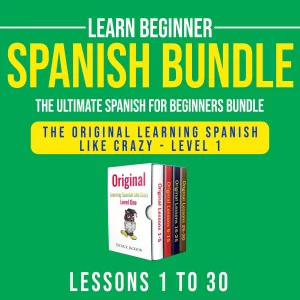
I received an email yesterday from a reader who asked, “Patrick, how are your Salsa classes going? You sent us an email a couple of weeks ago saying that you had just started Salsa classes and you have not mentioned anything about your Salsa classes since.”
Well, I am glad she asked. I am having a lot of fun in my Salsa classes and learning how to dance Salsa at the same time.
On the first day of classes, the Salsa instructor asked the class “does anyone know where Salsa originated from?
” The Colombianos in the class responded with “Puerto Rico” and “Cuba.” But only this “Neoyorquino” (New Yorker) knew the correct answer: Nueva York (New York)
The Colombianos in the class thought I was “loco” when I said that “Salsa se originó en Nueva York” Our Salsa instructor had to confirm that Salsa music did in fact originate in New York City before anyone believed me. That is, Salsa was founded by Puerto Ricans in New York (or “Newyoricans” or “Nuyoricans” as we say in New York City) — possibly with the help of some Cubans.
Learning Spanish With Salsa Music
By the way, listening to Salsa music is an excellent way to learn more Spanish and pick up lots of new Spanish. There are basically two types of Salsa music: “romántica” y “clásica”
You can learns lots of Spanish by listening to either one. I have a Colombian friend who told me that he has learned lots of new English words from listening to Country Western music.
Of course, you can also pick up lots of new Spanish vocabulary by listening to Merengue music (Dominican dance music). But I have found that the “letras” (lyrics) to Merengue music often don’t make sense and are often just “letras” for dancing and entertainment. On the other hand, Salsa music has “letras románticas” and “letras de amor” (lyrica about love).
How To Learn Spanish Slang
If you are interested in learning Spanish slang, then you may want to listen to Reggaetón music — which I would describe as Spanish reggae music mixed with Hip Hop music. Reggaetón actually originated in Panama from Panamanians with Jamaican ancestry, but it was popularized and by Puerto Rican Reggaetón artists.
If you are learning Spanish with your kids you’ll want to avoid listening to Reggaetón. Just like
someone who is learning English with his or her children will want to avoid listening to “gansta” rap.
But if you are not easily offended by “adult” lyrics, you can learn lots of Spanish slang from listening to the “letras” (lyrics) of Reggaetón music.
I have learned a lot of Spanish slang from
listening to Reggaetón music.
Here are a few of the words that you may pick up from listening to Reggaetón music.
1. Sandunguear – to dance close or as one would say in Spanish, to dance “cerca” or to dance “pegado” or “pegadito”
Sandungueo – provocative or very sensual style of dancing close. In the Jamaica, West Indies, this style of dancing is called “wining.”

2. pegado/pegadito – cerca (close); literally “glued”
3. tener antojo – to have a craving, often used in a sensual manner, for example, “tengo un antojo” – I have a (sensual) craving.
“Tener antojo” is similar to the phrase “tenger ganas” which you will often hear Spanish speakers use.
“Tener ganas” means “to feel like doing something” or “to have desires.” Por ejemplo (for example),
Tengo ganas de comer un churrasco.
I feel like eating a steak.
Tiene ganas.
He/she has (sensual) desires.
4. perrear – literally, to be like a “dog”; to go out to pick up women — “especialmente mujeres fáciles” (especially, easy women)
In Medellín, Colombia, there’s a slang word which means the same as “perrear.” And that word is “putear.”






So, if you’re already in with Fundalor, Fundalorlogin is where you probably wanna be. Get in there and win big, dude. Here’s the entry point:fundalorlogin
Với giao diện mượt mà và ưu đãi hấp dẫn, MM88 là lựa chọn lý tưởng cho các tín đồ giải trí trực tuyến.
Tham gia cộng đồng game thủ tại Go88 để trải nghiệm các trò chơi bài, poker phổ biến nhất hiện nay.
Khám phá thế giới giải trí trực tuyến đỉnh cao tại MM88, nơi mang đến những trải nghiệm cá cược thể thao và casino sống động.
I’ve recently started a blog, the information you offer on this site has helped me tremendously. Thank you for all of your time & work. “Marriage love, honor, and negotiate.” by Joe Moore.
kuwin sở hữu kho game đa dạng từ slot đến trò chơi bài đổi thưởng, mang đến cho bạn những giây phút giải trí tuyệt vời.
Enjoyed examining this, very good stuff, thankyou . “Be not careless in deeds, nor confused in words, nor rambling in thought.” by Marcus Aurelius Antoninus.
I needed to create you the very small note to give many thanks the moment again over the wonderful things you have documented above. It was really wonderfully open-handed of you in giving freely precisely what many of us could possibly have advertised as an ebook to get some dough for their own end, precisely since you could possibly have done it in case you wanted. The points additionally acted as a fantastic way to fully grasp other people have the same eagerness the same as my very own to find out good deal more pertaining to this problem. I believe there are lots of more enjoyable opportunities ahead for people who look into your site.
I think this is one of the most significant info for me. And i’m glad reading your article. But should remark on some general things, The web site style is great, the articles is really excellent : D. Good job, cheers
苹果签名,苹果超级签平台,ios超级签平台ios超级签苹果企业签,苹果超级签,稳定超级签名
Khám phá thế giới giải trí trực tuyến đỉnh cao tại MM88, nơi mang đến những trải nghiệm cá cược thể thao và casino sống động.
Hiya very cool blog!! Man .. Beautiful .. Superb .. I’ll bookmark your web site and take the feeds also…I’m satisfied to seek out so many helpful information here within the post, we want work out more strategies in this regard, thanks for sharing.
I truly wanted to type a simple note in order to appreciate you for all of the fantastic points you are giving out here. My extensive internet research has at the end been rewarded with beneficial details to go over with my close friends. I ‘d state that that many of us readers are undoubtedly fortunate to be in a great website with so many lovely professionals with good opinions. I feel pretty grateful to have discovered your site and look forward to tons of more excellent minutes reading here. Thanks a lot once more for all the details.
利用强大的谷歌蜘蛛池技术,大幅提升网站收录效率与页面抓取频率。谷歌蜘蛛池
Tham gia cộng đồng game thủ tại Go88 để trải nghiệm các trò chơi bài, poker phổ biến nhất hiện nay.
Đến với J88, bạn sẽ được trải nghiệm dịch vụ cá cược chuyên nghiệp cùng hàng ngàn sự kiện khuyến mãi độc quyền.
kuwin sở hữu kho game đa dạng từ slot đến trò chơi bài đổi thưởng, mang đến cho bạn những giây phút giải trí tuyệt vời.
Spanish sound effects often reflect expressive culture—claps for flamenco, “¡Olé!” in celebration, guitar strums, castanet clicks, bullfight horns, street chatter, and festive fireworks, capturing the vibrant rhythm of Spain.
UID_83003169###
Kenalan yuk! 🤝 Dengan guru inspiratif ini, Guru Dede Sulaeman yang mengajarkan cara merapikan pakaian di kelasnya. 👕👚🎓
UID_18563832###
Ini yang di ganti >>> Yuk, ketahui lebih lanjut tentang Syarat Gabung OECD dan Pentingnya Ratifikasi Konvensi Antisuap di sini! 🕵️♀️🔎📚.
UID_95859078###
Baru-baru ini, para pemain Mahjong Wins 3 dikejutkan dengan bocoran RTP yang diklaim bisa meningkatkan peluang kemenangan secara signifikan. Banyak yang percaya bahwa informasi ini membantu mereka mendapatkan hasil yang lebih konsisten dalam permainan. Jika Anda ingin tahu lebih lanjut, cek bocoran RTP Mahjong Wins 3 hari ini dan lihat apakah strategi ini benar-benar efektif.
UID_25978847###
situs terbaik hanya di slot gacor agentotoplay
Rattling wonderful information can be found on web blog . “There used to be a real me, but I had it surgically removed.” by Peter Sellers.
I’m not sure where you’re getting your info, but great topic. I needs to spend some time learning more or understanding more. Thanks for fantastic info I was looking for this info for my mission.
UID_83344528###
Inilah 🎉🎉 Pupuk Inovatif Kebun Riset Kujang yang bikin Wamen BUMN bangga! 💪🏻🇮🇩
UID_74743238###
Ini dia! 🎉🎉 ASN BKN Ubah Pola Kerja yang baru dan efisien! 🎉🎉.
UID_72339950###
Heboh! 📣🔥 Unjuk Rasa di Polda Jatim 📢 Menuduh Jokowi Terlibat Korupsi! 😱🔍
UID_57092237###
Berita gembira! 🎉 Pasokan Gas 3 Kg di Kramat Jati Kembali Normal 🎊 Siap-siap belanja gas, ya! 💪🔥
UID_72942561###
Berita Hot! 🔥🔥 Isa Rachmatarwata Tersangka Kasus Jiwasraya Buntut kerugian negara hingga 16,8 Triliun! 😲😲
UID_59407105###
berita dana x twitter viral berita dana desa ada disini !
I really appreciate this post. I have been looking all over for this! Thank goodness I found it on Bing. You have made my day! Thank you again!
The Best Premium IPTV Service WorldWide!
Fairly insightful submit. Never thought that it was this simple after all. I had spent a great deal of my time looking for someone to explain this subject clearly and you’re the only 1 that ever did that. Kudos to you! Keep it up
Hello, I started studying Spanish in middle school. At some point, a native speaker told me to listen to music in Spanish, any kind, and try to understand the words as a way to speed up my progress. I think it helped a lot. I became fluent and went on to teach and tutor Spanish, and to do a little work as a translator and interpreter. Great advice, Patrick! I started learning Salsa and Merengue years later, and ended up as assistant and later co-instructor for a couple of years with my teacher who is from Cuba. It was a blast, and keeps you in great shape! I really miss it.
Some friends of mine just came back from Medellín and Bogotá. They had an amazing time, and have almost convinced me to visit. Maybe in the Spring. One of my friends and her husband are even thinking about moving there. Sounds like it might be a great place for an African-American ex-pat or transplant.
Yes, Colombia is a wonderful place. In Colombia, they say “el único riesgo es querer quedarse” (the only risk is wanting to say)